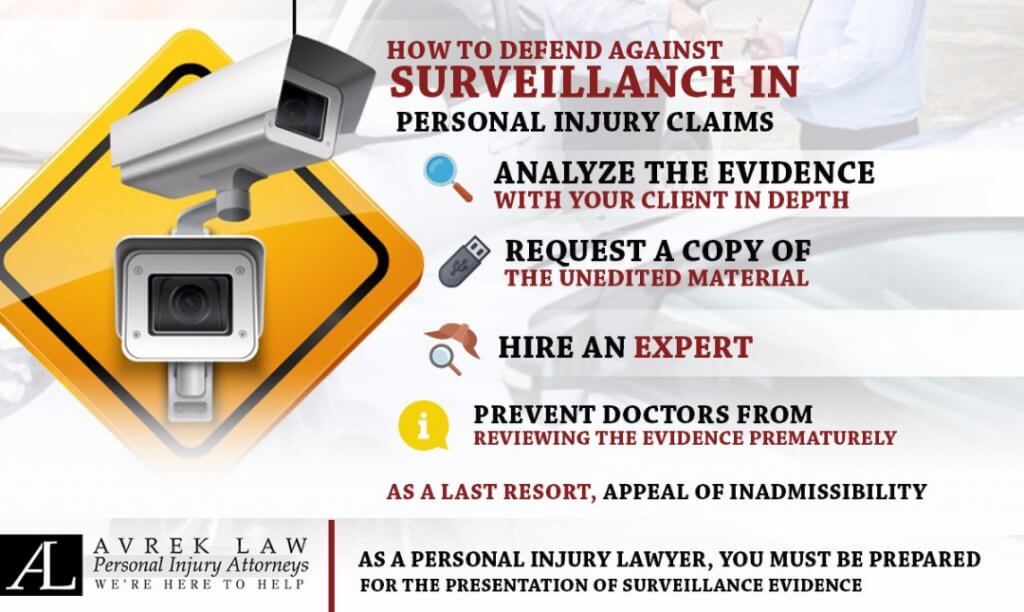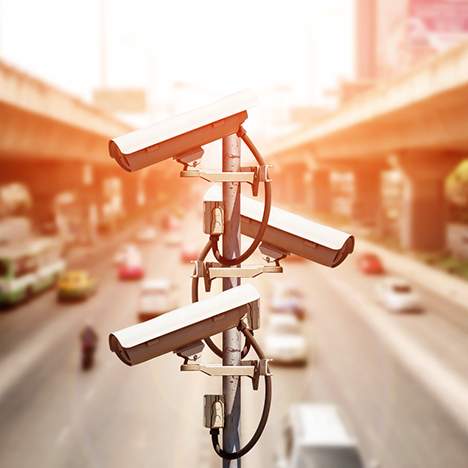Surveillance in personal injury claims refers to the close monitoring of a person, and the word carries a negative connotation. Personal injury surveillance evidence, as the name implies, are all those tests obtained by surveillance methods, such as security cameras, and so on. The resource is frequently used by insurance companies in those personal injury claims whose compensation amount is quite high.
In general, the presentation of surveillance evidence can be highly problematic for a plaintiff. For this reason, insurers invest large amounts of money in insurance claims surveillance methods, precisely to obtain evidence that may negatively affect the plaintiff’s credibility and position the case in favor of the insurers.
Only specialized lawyers like those at Avrek Law can counteract the presentation of surveillance evidence, as we said a moment ago, this usually produces confusion in any inexperienced person. However, the credibility of the client is also key to ensure that the insurance company surveillance tactics won’t be effective in the case. In other words, the lawyer in charge of the case must make sure that the client has told him the truth in its entirety.
Analyze the personal injury evidence with your client in depth
First, it is mandatory for you to perform a thorough analysis of the surveillance evidence with your client. Such an analysis will take a lot of time, but it is necessary to do it if you want to win the case or, failing that, prevent this resource from diminishing the amount of the compensation. Sometimes insurers aren’t out to win the case, they may want to reduce the number of damages for which they are liable. To avoid this, it is essential that you make a space in your agenda to dedicate it exclusively to the analysis of the evidence.
Surveillance in personal injury claims has been conveniently manipulated in a number of cases. The insurer presents partial recordings or only presents some of the recordings and do not show the rest, as those remaining recordings could be used against the insurance companies.
Again, we reiterate that it is important that the client tells you the whole truth and does not exclude the smallest detail, as in that way you can formulate a more effective defense against the surveillance evidence and increase the chances of winning the case.

Request a copy of the unedited personal injury surveillance
Personal injury evidence surveillance material is extremely long, as no one knows beforehand when supervised people will do something unusual, unexpected or suspicious. The insurance companies must cut out the surveillance material, presenting only that part in which the person under surveillance has unusual or suspicious behavior.
Insurance companies can select only what they can use in their favor and discard everything else they cannot. For this reason, you must demand a copy of the material that is not edited. It is impossible for the insurance company not to have that material; and if it does not, it would be highly suspect and the credibility of the insurer should be questioned.
Once you have this unedited material, you should review it thoroughly. The time it will take this review can be lengthy, but it will be worth it, as you can find parts that you can use in your favor. With these parts you can dismantle any allegation from the insurance company. That is why we make the same recommendation as in the previous point: make a space in your personal agenda so that you dedicate it exclusively to the revision of the unedited material.
Hire a personal injury surveillance expert
Often, lawyers require the opinion and advice of an expert. In this case, it is highly convenient to hire an expert in surveillance material, either to corroborate your suspicions regarding the evidence provided by the insurer; to expedite the process of reviewing the evidence; or to get new elements that can give more support to your defense.
An expert in surveillance evidence can examine the dates of each of the recordings. We have seen cases in which there have been discrepancies between the material presented by the insurance company and the unedited material. We have also witnessed cases in which the insurance company has shown material with a time record whose scenes do not match those of the unedited material.
With the assistance of experts, Avrek Law Firm’s attorneys have found other methods of manipulating the evidence, including selective recording, which consists of monitoring the client at specific times. These types of discrepancies can only be identified by an expert, so it is highly recommendable to go to one in case of presentation of surveillance evidence.
Prevent doctors from reviewing the personal injury evidence prematurely
In addition to “things you must do,” there are also “things you should not do” in case an insurer presents surveillance evidence. One of them is to allow doctors review the evidence prematurely, as they can be influenced and make judgments that may be final in the verdict of the judge.
Ideally, experts in the medical area must review the material once it has been submitted to the exams previously explained. Keep in mind that they are only experts and professionals in his or her area, so they are vulnerable to manipulation through altered evidence.
This point is important if you want to get a victory in the case. A joint medical statement can tear down any chance of getting adequate compensation. You must prevent that material from reaching the hands of doctors without having been previously analyzed.
Appeal of inadmissibility of surveillance evidence

Another way to counteract the presentation of personal injury surveillance evidence is by filing an appeal of inadmissibility. However, you should be aware that this remedy can only be used if the surveillance evidence is presented late; that is, if it is presented at an advanced stage of the trial.
There are two ways of validly filing an appeal of inadmissibility. The first is that – as we said in the previous paragraph – you claim that the surveillance evidence is inadmissible as it is being used late, so its presentation can constitute a trap.
The second is that you claim that this personal injury evidence was obtained by violating the privacy of your client, as long as you have previously reviewed it and obtained elements that prove your allegation. One of Avrek Law’s attorneys handled a case in which the operators pretended to be plaintiff’s clients in order to enter their house and perform the surveillance procedure.
However, this second form can easily be refuted, as privacy is not an absolute right. On the contrary, according to the Human Rights Act of 1998, the right to privacy is stipulated only for public authorities. A skilled personal injury lawyer can argue that and dismantle your appeal of inadmissibility.
In fact, the allegation of privacy has rarely been used in the claims of personal injuries or traffic accidents, as the Human Rights Act of 1998 does not extend the right of privacy to all people.
But, be careful with this: We are not saying that there is no right to privacy. We are simply clarifying that this right is not absolute and that it is not valid in the claims of personal injury claims.
Conclusions of Personal Injury Surveillance
A personal injury lawyer must be prepared for the presentation of surveillance evidence. Everything seems to indicate that this resource will be used frequently by insurers.
Despite this, the outlook is encouraging, as a review of jurisprudence reveals that the effectiveness of the resources is almost nil. Basically, this is explained as the presentation of personal injury surveillance evidence is not useful against a honest client who only seeks compensation for their injuries.
At the same time, future clients should be notified that there is a high probability they will be monitored, so they should act normally and not in a suspicious manner, as insurers will not hesitate to use that against him.
Hiring an Attorney to Handle Surveillance in Personal Injury Claims
Finally, if the person reading this is not a lawyer, we recommend that you contact Avrek Law Firm so that we can advise you correctly. If this is not the case, we recommend that you write down Avrek Law Firm’s contact information, as you may need our services at some point.
If you’re looking for the personal injury surveillance attorney, Avrek Law wants to hear about your case. Our legal team has a remarkable track record with Over $2 Billion recovered for clients in over 45,000 cases. Contact us or fill out a form for a free consultation – we’re here to help!
